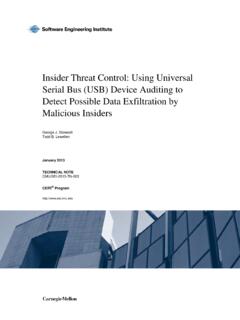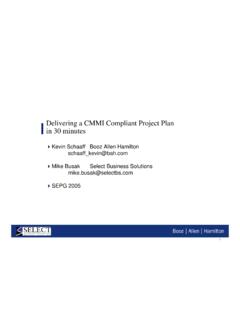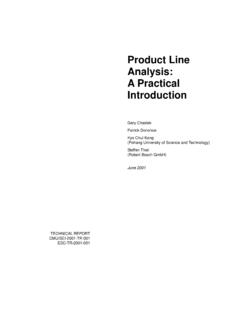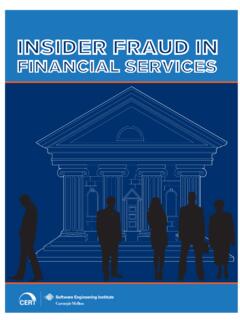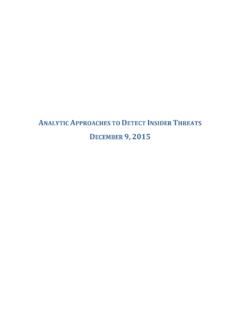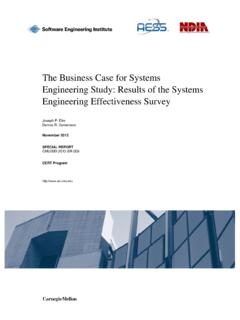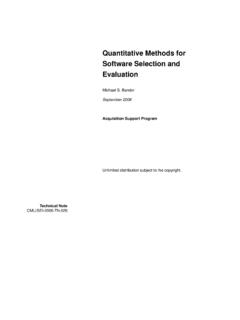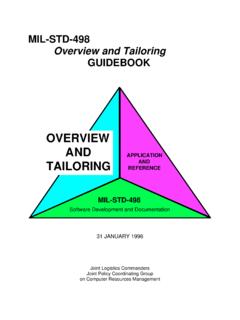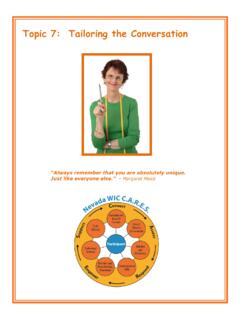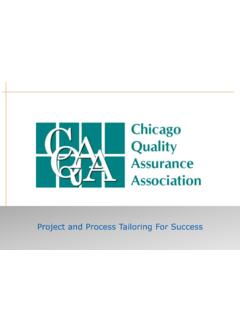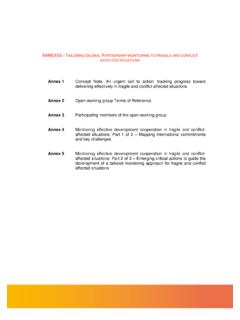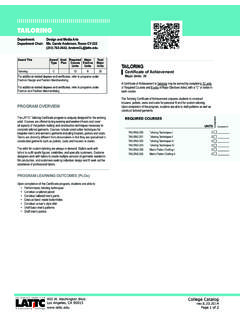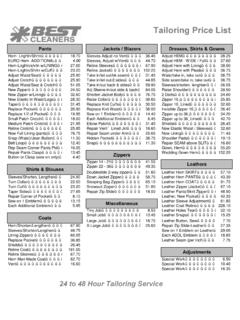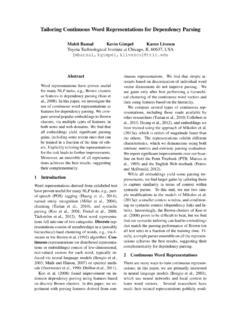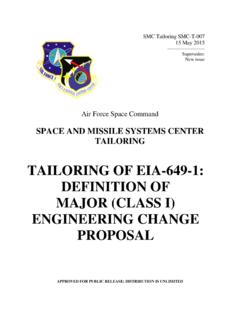Transcription of Process Tailoring and the Software Capability Maturity Model
1 Technical ReportCMU/SEI-94-TR-024 ESC-TR-94-024 Process Tailoring and thethe Software Capability Maturity ModelMark P. GinsbergLauren H. QuinnNovember 1995 Error! Reference source not ReportCMU/SEI-94-TR-024 ESC-TR-94-024 November 1995 Process Tailoring andthe Software Capability Maturity ModelMark P. GinsbergSEI Resident Affiliate - Hughes Missile Systems CompanyLauren H. QuinnSEI Resident Affiliate - Loral Federal SystemsUnlimited distribution subject to the copyrightSoftware Engineering InstituteCarnegie Mellon UniversityPittsburgh, PA 152132 Error! Reference source not report was prepared for theSEI Joint Program OfficeHQ ESC/AXS5 Eglin StreetHanscom AFB, MA 01731-2116 The ideas and findings in this report should not be construed as an official DoD position.
2 It is published in theinterest of scientific and technical information THE COMMANDER(signature on file)Thomas R. Miller, Lt Col, USAFSEI Joint Program OfficeThis work is sponsored by the Department of 1994 by Carnegie Mellon to reproduce this document and to prepare derivative works from this document for internal use isgranted, provided the copyright and No Warranty statements are included with all reproductions and for permission to reproduce this document or to prepare derivative works of this document for externaland commercial use should be addressed to the SEI Licensing WARRANTYTHIS CARNEGIE MELLON UNIVERSITY AND Software ENGINEERING INSTITUTE MATERIAL IS FURNISHED ON AN AS-IS BASIS. CARNEGIE MELLON UNIVERSITY MAKES NO WARRANTIES OF ANY KIND, EITHER EXPRESSED ORIMPLIED, AS TO ANY MATTER INCLUDING, BUT NOT LIMITED TO, WARRANTY OF FITNESS FOR PURPOSE ORMERCHANTABILITY, EXCLUSIVITY, OR RESULTS OBTAINED FROM USE OF THE MATERIAL.
3 CARNEGIE MELLONUNIVERSITY DOES NOT MAKE ANY WARRANTY OF ANY KIND WITH RESPECT TO FREEDOM FROM PATENT,TRADEMARK, OR COPYRIGHT work was created in the performance of Federal Government Contract Number F19628-95-C-0003 with Carnegie Mellon Universityfor the operation of the Software Engineering Institute, a federally funded research and development center. The Government of the UnitedStates has a royalty-free government-purpose license to use, duplicate, or disclose the work, in whole or in part and in any manner, and tohave or permit others to do so, for government purposes pursuant to the copyright license under the clause at of this document are available through the National Technical Information Service (NTIS). For information on ordering, pleasecontact NTIS directly: National Technical Information Service, Department of Commerce, Springfield, VA 22161.
4 Phone: (703) document is also available through the Defense Technical Information Center (DTIC). DTIC provides access to and transfer ofscientific and technical information for DoD personnel, DoD contractors and potential contractors, and other Government agencypersonnel and their contractors. To obtain a copy, please contact DTIC directly: Defense Technical Information Center / Attn: BRR / 8725 John J. Kingman Road / Suite 0944 / Ft. Belvoir, VA 22060-6218. Phone: (703) 767-8274 or toll-free in the 1-800 225-3842).Use of any trademarks in this report is not intended in any way to infringe on the rights of the trademark of of Intended Organization of This Interpretation vs. General Approach42 Tailoring for the Capability Maturity Considerations for Tailoring with the Organizational Customer and End-User Tailoring by Business Impact of Maturity Level on Tailoring133 Requirements Analysis / Tailoring with the Extensions/ Extensions/ Role Role Extensions/ and the Infrastructure Common Requirements274 The Organization's Standard Software Process and Tailoring Project Customer and End-User Relationships and Tailoring by Business Impact of Maturity Level on Developing the Tailoring Developing the Project's Specific Software Development Plan36 CMU/SEI-94-TR-24i5 Data Sources396 Summary417 References43 Appendix A.
5 Glossary45 Appendix B. Acronyms51 Appendix C. Example Codes for Tailoring Tables53iiCMU/SEI-94-TR-24 List of FiguresFigure 1-1: Volumes of the Software Capability Maturity Model2 Figure 1-2: Correlating /Adjusting to Alternate Environments4 Figure 2-1: The IDEAL Model for Process Improvement9 Figure 2-2: A Tailoring Framework10 Figure 2-3: Process Tailoring at Levels 1 and 214 Figure 4-1: Project Tailoring 38 CMU/SEI-94-TR-24iiiList of TablesTable 3-1: Example of SPF Output Checklist (for Requirements Management) 17 Table 3-2: Example of SPF Activities Checklist (for Organization ProcessFocus)19 Table 3-3: Description of Disposition Code20 Table 3-4: Example of SPF Role Translation Table 22 Table 3-5: Example of SPF Role Checklist (for Training Program)23 Table 3-6.
6 Example of Matrix of SW-CMM Key Practices and Activity Roles24 Table 3-7: Focus Areas of CMM Common Features26 Table 4-1: Example of Tailorable Process Elements36ivCMU/SEI-94-TR-24 Process Tailoring and the Software Capability MaturityModelAbstract. The Software Capability Maturity Modelsm (SW-CMM)sm is serving asthe foundation for a major portion of the Process improvement being undertakenin the Software industry. It is composed of two volumes: the Capability MaturityModel for Software , and the Key Practices of the Capability Maturity Model . Thekey practices of the SW-CMM are expressed in terms that reflect normalpractices of organizations that work on large, government contracts. There is,however, a significant population of Software -producing and -acquiringorganizations, operating in different environments, for which the key practicesrequire significant interpretation and/or Tailoring prior to application.
7 This reportpresents a Tailoring framework that identifies Process artifacts, tailoringprocesses, and their relationships to project artifacts, and explores the nature ofvarious kinds of Tailoring used in the definition and development of softwareprocess descriptions. Techniques appropriate to each type of Tailoring are thendiscussed. The general approach utilizes and builds upon the Software ProcessFramework, whose purpose is to provide guidance for designing, analyzing, andreviewing Software processes for consistency with the Software Capability Maturity Model (SW-CMM), developed by the SEI, serves as thefoundation for a major portion of the Process improvement being undertaken in the softwareindustry. The SW-CMM is composed of two volumes: The Capability Maturity Model forSoftware [Paulk 93a] and the Key Practices of the Capability Maturity Model [Paulk 93b].
8 The first volume contains a description of the five-level Model , descriptions of each of thefive levels, and an operational definition of the Model . The second volume contains keypractices that correspond to the key Process areas (KPAs) at each Maturity level of the set of all possible Software projects and project environments (project space) is solarge, a set of key practices suitable for use by all potential organizations and projects wouldbe either very general or very complex, and would not be easily applied to any one project orenvironment. Therefore, the key practices were expressed with a specific subset of projectspace in mind: contractors concerned with the development of large, Software -intensivecritical systems (see Figure 1-1).
9 However, It should be noted that the SW-CMM has beensuccessfully adapted to other environments and serves as the basis for Software processimprovement efforts in many different Capability Maturity Modelsm and CMMsm are service marks of Carnegie Mellon MaturityModel forSoftware (TR-24)Key Practicesof the CapabilityMaturity Model (TR-25)INSTANTIATET arget EnvironmentLargeCriticalDevelopmentGover nment AgencyFigure 1-1: Volumes of the Software Capability Maturity of TailoringThe Tailoring approaches described in this report are somewhat formal. Frequently Tailoring (and interpretation) will be more informally performed. The concepts and approachesdescribed here should be useful for Tailoring (and interpretation) at various levels PurposeAlthough the SW-CMM is recognized as a valuable contribution to the state of softwareprocess improvement, there is a large population of Software -producing and -acquiringorganizations that need to interpret and/ or tailor the key practices before they can beapplied.
10 This report explores some of the areas where adjustments to the SW-CMMpractices will most likely be required and proposes techniques designed to resolve theconflict between maximizing both Process commonality and project work represents the knowledge and analysis of the authors, to date. In the spirit of theSW-CMM and continuous Process improvement, we welcome any feedback, comments, Intended AudienceThis report is intended for use by members of Process groups and others interested in thedevelopment of Software processes, which are compatible with the SW-CMM, fororganizations and projects. It is assumed that the user is familiar with the structure andcontent of the SW-CMM and is knowledgeable in Software engineering and softwaremanagement Organization of This ReportThe report is organized into six primary chapters and three appendices.
